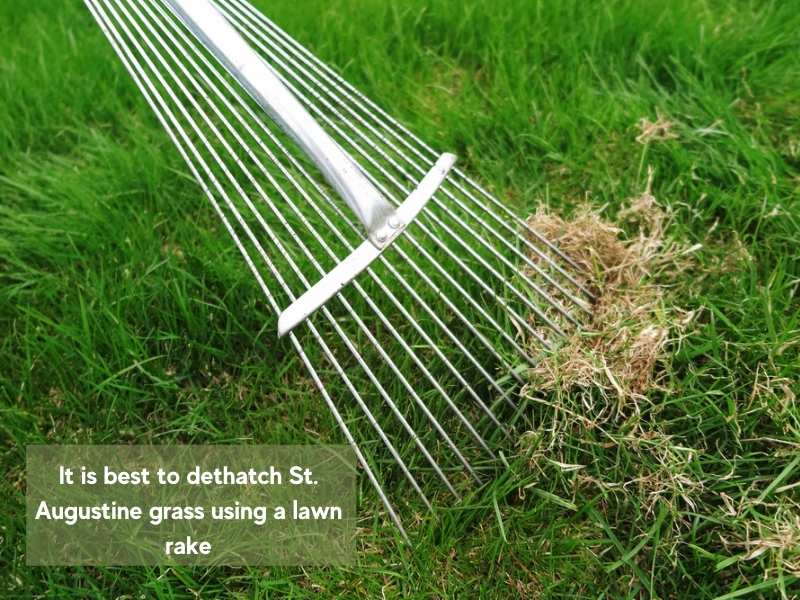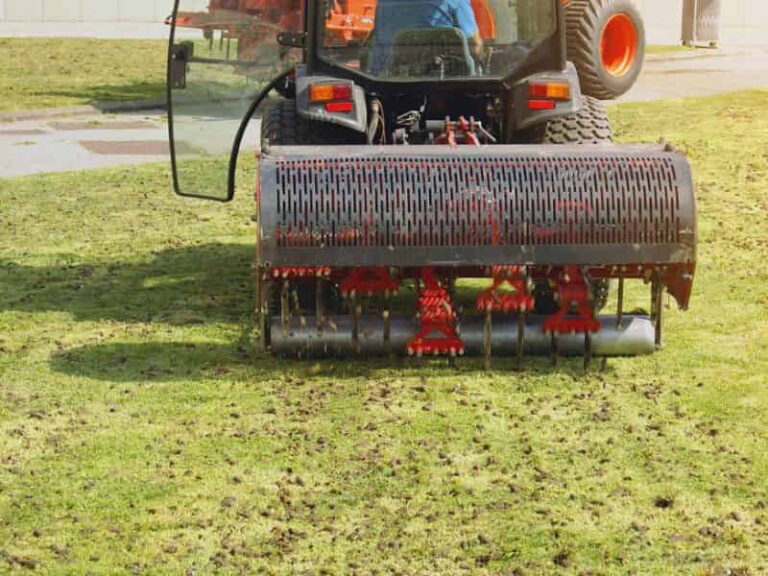Can You Dethatch St. Augustine Grass? Steps and Precautions
Removing thatch from St. Augustine grass lawns is a risky maintenance practice that can leave your lawn damaged if not done correctly. While it is not always required, dethatching for this turfgrass can help prevent some pests and diseases easily. So, how do you dethatch St. Augustine grass without damaging it?
Dethatching St. Augustine grass can cause severe damage if you use a power rake. The practice isn’t necessary unless the thatch buildup is thicker than 0.5’’. To dethatch safely, mow the lawn at 2’’ then water it a day earlier. Dethatch using a verticutter, making only single passes per section.
Should you dethatch St. Augustine grass?
You should dethatch your St. Augustine grass turf only if the thatch layer is more than 0.5-inches thick. Such a thick layer of thatch restricts the intake of oxygen, water, and nutrients into the soil.
Massive thatch layers also hamper root development, as the above-ground runners of St. Augustine grass are unable to send new roots down through the thick thatch into the soil to kick-start new growth. As a result, the grass spreads slower and the turf takes longer to fill in.

Note: Excessive thatch at the base of turfgrass also makes the grass more vulnerable to disease and insect infestations.
To avoid damaging your St. Augustine grass, there are certain cautionary measures you should take into account before dethatching the lawn. For starters, if you’re using a vertical mowing machine, make sure the blades are at least three inches apart. Second, you should only make a single pass over the St. Augustine turf to prevent severe turf damage.
What causes thatch in St. Augustine grass?
Thatch is caused by the buildup of dead plant material at the base of the St. Augustine grass blades. The dead plant material comprises of grass clippings, dead leaves, and even small twigs. However, St. Augustine grass is not as prone to thatching buildup as most other types of grass because it grows via above-ground runners called stolons.
It’s these stolons that form a canopy with the perfect conditions (wet, cool, dark, and windless) for microbes to thrive. Large populations of soil microbes quickly decompose thatch material into usable nutrients for the grass, while also preventing the buildup of thatch at the same time.
Therefore, if the thatch layer on your St. Augustine lawn is thicker than 0.5-inches, it means that the lawn is poorly maintained.
Here are the main causes of thatch in St. Augustine grass:
Insufficient moisture
Just like compost material, thatch decomposes faster if it’s wet. Dry thatch breaks down slowly, resulting in the thatch layer building up faster than it can decompose. To prevent thatching caused by dryness, water your St. Augustine lawn once per week for at least 45 minutes.
Poor soil aeration
Thatch also breaks down faster if the turf is well-aerated. Microorganisms that break down thatch are unable to thrive and multiply fast enough if the soil oxygen levels are insufficient.
For increased oxygen circulation into your turf soil, you should aerate the turf in the spring using a core aerator.
Overwatering and overfertilization
Too much water and fertilizer can cause your St. Augustine lawn to grow too fast. The faster the lawn grows, the more frequent you’ll mow to keep it short, which leaves too many grass clippings at the base of the turf. The clippings decompose at a much slower rate than they are added causing thatch buildup in St. Augustine lawns.
When to dethatch St. Augustine grass
St. Augustine grass is best dethatched from mid to late spring when the turf is beyond the dormancy stage and is actively growing. Vigorous growth in spring enables the grass to reach a safe mowing height quickly. Always mow the lawn before dethatching to make it easier to remove thatch that’s closer to the soil.
Dethatching in the Spring gives St. Augustine turfs enough time to recover since the active growth season lasts up to late summer.
It’s not a good idea to dethatch St. Augustine grass in the fall because the grass is unlikely to recover from the stresses of dethatching during the cool season. You’ll likely end up with dead and bare spots on your lawn if you dethatch during the cool season.
As for the dethatching frequency, the specific variety of St. Augustine grass you’re growing is the most significant determining factor. Some cultivars need to be dethatched at least once every year while others take as long as two years to form heavy thatch that requires dethatching.
How to Dethatch St. Augustine Grass
To safely dethatch St. Augustine grass, use tools that effectively remove thatch but cause the least damage. These include hand rakes and vertical mowers. Don NOT use a power rake to dethatch a St. Augustine lawn because it can cause extensive damage that’ll taje a long time to recover.
Here’s how to dethatch St. Augustine grass:
1. Mow the lawn at 2 inches
Before you can dethatch your St. Augustine lawn, you should prep the turf by mowing it to allow the dethatcher to easily gain access to and pull out the thick layer of thatch below the living grass blades.
When mowing St. Augustine for dethatching, cut the grass at a low blade height of 2-inches. At this mowing height, you’ll be able to give the dethatching tool enough access without cutting off too much of the stolons, thus, preventing excessive damage to your lawn.
2. Water the lawn 24 hours before dethatching
Water your St. Augustine lawn at least 24 hours before dethatching it, as it softens down hard-packed layers of thatch, making them easier to remove.
Watering also reduces the stress on the grass and gives it a head start in recovering. Keep in mind that the soil should only be moist before dethatching. Overwatering can leave the lawn wet and muddy, which can attract fungus in your St. Augustine grass.
In addition, too much water can make the lawn too soft. As such, you risk yanking up patches of turf and damaging the lawn even further.
3. Run the dethatcher in your lawn
Since dethatching a St. Augustine lawn using a power rake isn’t recommended, this section only entails how to dethatch St. Augustine turfgrass using a vertical mower or a hand rake.
Dethatching using a vertical mower
Dethatching using a vertical mower is also referred to as verticutting. A vertical mower/verticutter resembles a traditional lawn mower, but replaces the single, horizontal blade with multiple, vertical blades, tines, or prongs. These blades pull up thick layers of thatch to the lawn surface for easier collection.
To properly dethatch St. Augustine turfgrass using a vertical mower, set the blades 3 inches apart and pass over the grass only once. Do not pass over the same spot twice.
These two cautionary measures will help to prevent extensive damage to your St. Augustine turf. After pulling the excessive thatch, finish off the job by removing the loose thatch from the surface of your lawn using a hand rake.
Dethatching using a hand rake
I recommend using a hand rake or a thatch rake for dethatching only if the yard is small in size (no larger than 1500- square feet). Using a hand rake is slow and can be tiresome.
Despite the downsides, a hand rake is the best and easiest dethatching tool to use. Even when your turf is uneven. The rake will easily fit into the inaccessible areas where a verticutter or power rake can’t be used.
Whether you’re using a vertical mower or a hand rake, try to remove as much thatch as possible, leaving only a thin layer. While agronomy experts have noted that having up to 0.5-inches of thatch is beneficial to turf grasses, you don’t want to leave behind this last ½ inch as it’s likely too compact. Ideally, you should remove most of it and let a new layer of thatch form naturally.
Pro tip: After dethatching your lawn, you can dispose of the thatch matter or add it to your compost material. Leaving it on your lawn can cause additional buildup and encourage pests like chinch bugs in your St. Augustine grass turf.
4. Aerate the lawn
Aerate your lawn after dethatching so that the new layer of thatch that forms after decomposes faster due to thriving microbial life. You’ll achieve better aeration after dethatching as the core aerator machine doesn’t have to work its way through heavy thatch before reaching the soil.
Aeration not only increases the air supply to microbial organisms that decompose thatch but also boosts the supply of water and nutrients into the soil. This, in turn, helps to speed up St. Augustine turfgrass recovery after dethatching.
5. Apply a slow-release fertilizer
Applying fertilizer after dethatching and aerating your St. Augustine lawn will help it recover quickly from the stress I’d recommend a slow-release fertilizer such as Milorganite as it will feed the grass with safe, organic nitrogen over a few months.
Fertilizer absorbs much easier into the soil if there’s no heavy layer of thatch impeding it. Slow-release nitrogen fertilizer is the best for lawn recovery in the growing season.
Precautions and Dangers of Dethatching St. Augustine Grass
When dethatching St. Augustine grass, take into account the following precautionary measures.
Do NOT use a power rake
The most effective dethatching tool for St. Augustine grass is a vertical mower because it pulls out heavy thatch with minimal damage to the grass. A hand rake is even less-aggressive than a vertical mower, but is laborious to use due to the sheer amount of time and passes needed to effectively complete the job.
DO NOT USE A POWER RAKE to dethatch St. Augustine grass as this tool is aggressive and will remove most of the grass stolons as well, causing extensive damage to your lawn.
While several types of turfgrasses grow by way of both above-ground stolons and under-ground rhizomes, St. Augustine only spreads and fills in by way of runners (stolons). As such, you should avoid using aggressive dethatching tools like power rakes as they’ll damage most of the stolons leaving minimal chances of turf recovery. Vertical mowers and hand rakes are recommended instead.
Always dethatch at the right time
Being a warm-season turfgrass, you should dethatch St. Augustine grass in the spring (onset of the growing season) for faster recovery. Avoid dethatching in the fall as the St. Augustine turf is going dormant and there are minimal chances of recovery from damage caused by dethatching.
References
- University of Illinois Extension, LawnTalk: Managing Thatch in Home Lawns
- Chuck Burgess and Trent C. Hale, PhD, Former Extension Turfgrass Specialist, Clemson University: St. Augustinegrass Yearly Maintenance Program


![Can You Lay Sod Over Weeds? [How to Sod a Weedy Area]](https://lawnmodel.com/wp-content/uploads/2021/01/Can-you-lay-sod-over-weeds-in-lawn.jpg)
